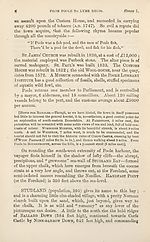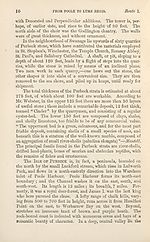Download files
Complete book:
Individual page:
Thumbnail gallery: Grid view | List view

Route i.
SWANAGE.
a fine view of purple heaths to the north, and the deep green
waters of the channel stretching far away towards the setting sun.
About three quarters of a mile north-west, stands, on a low green
knoll, the Aggle-stone (i.e., Holy Stone—halig stan, Saxon), a
rude misshapen block of ferruginous sandstone, whose origin is
not easily arrived at. We believe it to have been a cromlech, or
grave-mark—the memorial-stone of some old Celtic hero—but
the peasants tell you that it is the devil’s crest, or cap, which he,
when resting one day upon the Needles, hurled at the gleam¬
ing towers of Corfe Castle. He missed his aim, however, and
the stone fell where we see it now ; nor need we wonder, inasmuch
as it weighs full 400 tons, and measures 37 feet in length, 15
feet in height, and 19 feet in width.
Rounding Handfast Point, and its Pinnacles, popularly called
“Old Harry and his Wife,” and passing the deep cavern of
Parson’s Barn, we enter Swanage Bay.* Here in a cove, or
recess, termed Punfield, we meet with strata of Firestone, Gault,
Greensand, and Wealden clay in a highly inclined position.
“ The middle series of the Wealden deposits, the Hastings Sands,
which are not visible in the Isle of Wight, form the line of cliffs
from Punfield to Swanage. These beds consist of sands, clays,
and calcareous grits, enclosing- seams and disseminated masses of
lignite, and containing bones of reptiles, etc. The sea-shore is
often strewn with fossil trees, and rolled bones of the Iguanodon
and other animals, that have been washed out of fallen masses of
the strata. The tract on which the town of Swanage stands, is on
the line of junction between the Hastings beds and the Purbeck
group ; the latter comprises clays, sands, and limestones, with
bands of shelly marbles, calcareous slates, and coarse limestones,
full of small paludinse, cyclades, and other fresh-water shells”—
(Mantell). In 1837, a fossil crocodile, embedded in a large slab
of fawn-coloured limestone, was discovered in one of the Swanage
quarries.
SWANAGE (population, 2000. Inns: Royal Victoria, and
Ship)—i.e., Swan-wic, the Swan-village—consists of one long,
sloping thoroughfare of decent houses, with some minor streets,
enjoying a glorious prospect of down, and cliff, and sea. Its
Church, dedicated to St. Mary, is an Early English building,
* The Danish fleet, repulsed by Ring Alfred at Wareham, was
wrecked here in 877.
SWANAGE.
a fine view of purple heaths to the north, and the deep green
waters of the channel stretching far away towards the setting sun.
About three quarters of a mile north-west, stands, on a low green
knoll, the Aggle-stone (i.e., Holy Stone—halig stan, Saxon), a
rude misshapen block of ferruginous sandstone, whose origin is
not easily arrived at. We believe it to have been a cromlech, or
grave-mark—the memorial-stone of some old Celtic hero—but
the peasants tell you that it is the devil’s crest, or cap, which he,
when resting one day upon the Needles, hurled at the gleam¬
ing towers of Corfe Castle. He missed his aim, however, and
the stone fell where we see it now ; nor need we wonder, inasmuch
as it weighs full 400 tons, and measures 37 feet in length, 15
feet in height, and 19 feet in width.
Rounding Handfast Point, and its Pinnacles, popularly called
“Old Harry and his Wife,” and passing the deep cavern of
Parson’s Barn, we enter Swanage Bay.* Here in a cove, or
recess, termed Punfield, we meet with strata of Firestone, Gault,
Greensand, and Wealden clay in a highly inclined position.
“ The middle series of the Wealden deposits, the Hastings Sands,
which are not visible in the Isle of Wight, form the line of cliffs
from Punfield to Swanage. These beds consist of sands, clays,
and calcareous grits, enclosing- seams and disseminated masses of
lignite, and containing bones of reptiles, etc. The sea-shore is
often strewn with fossil trees, and rolled bones of the Iguanodon
and other animals, that have been washed out of fallen masses of
the strata. The tract on which the town of Swanage stands, is on
the line of junction between the Hastings beds and the Purbeck
group ; the latter comprises clays, sands, and limestones, with
bands of shelly marbles, calcareous slates, and coarse limestones,
full of small paludinse, cyclades, and other fresh-water shells”—
(Mantell). In 1837, a fossil crocodile, embedded in a large slab
of fawn-coloured limestone, was discovered in one of the Swanage
quarries.
SWANAGE (population, 2000. Inns: Royal Victoria, and
Ship)—i.e., Swan-wic, the Swan-village—consists of one long,
sloping thoroughfare of decent houses, with some minor streets,
enjoying a glorious prospect of down, and cliff, and sea. Its
Church, dedicated to St. Mary, is an Early English building,
* The Danish fleet, repulsed by Ring Alfred at Wareham, was
wrecked here in 877.
Set display mode to:
![]() Universal Viewer |
Universal Viewer | ![]() Mirador |
Large image | Transcription
Mirador |
Large image | Transcription
| Antiquarian books of Scotland > Adventure and adventurers > Black's guide to the counties of Dorset, Devon, & Cornwall > (29) |
|---|
| Permanent URL | https://digital.nls.uk/142586726 |
|---|
| Description | Thousands of printed books from the Antiquarian Books of Scotland collection which dates from 1641 to the 1980s. The collection consists of 14,800 books which were published in Scotland or have a Scottish connection, e.g. through the author, printer or owner. Subjects covered include sport, education, diseases, adventure, occupations, Jacobites, politics and religion. Among the 29 languages represented are English, Gaelic, Italian, French, Russian and Swedish. |
|---|

